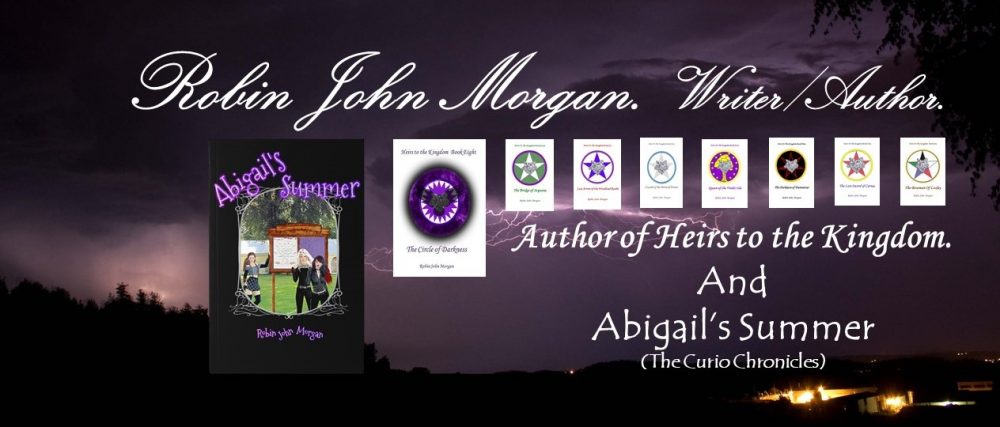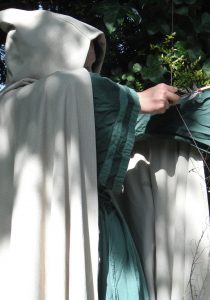One of the most visually identifiable aspects of HTTK is without doubt the cloak. In the first book Robbie and Billy both receive a new one, which was made by Steph and Runestone. It is a garment that in the very early stages of HTTK is pretty dominant, and in a lot of the conversations I have in regard to the books, most people just assume that I included the cloak to add to the modern/medieval feelings of the transit back in time in which all the characters live.
The symbolism of the hooded man has to be a long hooded and cloaked figure, and where I must admit a cloak was indeed the perfect vehicle for the image I wanted to create, I actually shied away from it at first. I was very aware when writing the first book that using the words Bowman and Loxley in the title, a lot of people would instantly think this was yet another Robin Hood story, which for those of you have read HTTK, you will know that is very much not the case.
I spent a lot of time creating the world in which my characters would live, and the most important aspect of it would be that it was set in the year 2038, so it would be a futuristic tale. I was embarking on a world torn apart and destroyed by a virus, which lead to anarchy and destruction, leaving those who survived with very little. The villain of the story with his Cutters would set about collecting as much of the old world life as possible, and so those who barely survived, were faced with the task of starting from scratch in a world outside of town and city life. In my mind they would have been left with very little and had literally only the clothes on their backs.
From disaster to the start of book one, twenty six years have elapsed, and as I planned the start of my world, it became quite clear that those survivors would have had to toil hard to make it through, and the most obvious factor here would be wear and tear of the few articles of clothing they possessed. I think it is quite obvious that they would have no choice but to create new clothing, and it is here that the skills of the old would be a major factor. I imagined those very few of the older generations would be the saviours of the masses, because they would still have the skills required to move the survivors forward. In my mind the elders of each community would be a vital part of survival, something I actually feel in today’s modern life where we take our older generations for granted, we all miss the point that their early life was set to a background long before modern technology, where they literally learned the skills to create and repair most things.
The elderly would become the teachers of the old skills, making them one of the most important aspects of a new community, as they still remember the crafts of weaving, patching, darning, knitting and crochet. Even if they were not able to handle the work load of creating a new cottage industry, they would still be able to teach the young, and this is yet another reason why characters such as the Kirk sisters, Agatha Patterdale and Ruben Stein are so very important to the village life of Loxley. I am not sure how many of the older generations you may have spotted, but they are there weaving in and out of the story throughout all the books. Alfie and Lee Sherman, Old Joe, Fuse and Alf the butcher play vital roles in this story; even Oscar Hargreaves had his part to play as book seller and more importantly printer.
Runestone and Steph run Trinkets and Trousers, the shop that supplies many articles of clothing, and if you notice employ quite a few extras weaving and sewing, even Maddy and Una who were raised at a time long before the modern world, are gratefully welcomed into the community and play their parts as teachers working in this industry.
I gave a lot of thought to the clothing, and did at first think some people would indeed seek out supplies to stock pile, enter Harry and Smokes and also the Cutters, but even with a great deal of salvage from the last remnants of the modern world, there still would not be enough to clothe a new generation of woodland living people, and so I turned my attention to more practical means of protection from the cold or the hot summer sun.
In today’s world wearing a cloak would be seen as old fashioned, and to be honest those who wear them would be considered quite strange and bonkers, I know as I actually own a real woollen woodsman cloak replicated perfectly to the medieval period. It is a heavy winter cloak, and it is both thick and heavy to wear, but I must confess it is so comfortable to wear, that I have on occasion slipped on and thoroughly enjoyed the experience.
Back in 2006 I made one out of a blanket as I looked at what would be the best and most suitable article of clothing to wear. Few people realise that actually the cloak has been worn for thousands of years, and its demise is relatively a recent thing. Wearing a cape or cloak was quite common right up until the mid-1940’s and in some circles they were still worn right through to the late 1980’s. I remember many hippies who wore poncho’s and wraps in the early seventies, and yes there was still the odd eccentric who wore a cloak during those days also. But the simple fact remains that the cloak has been around as a worldwide phenomenon for a very long time, but why I asked myself?
Simply put, I think it is because the cloak is possibly the easiest thing to make from a long rectangular piece of fabric. A basic cloak is easily fashioned and very practical, I made one and went out into the woodland to test it and see. I must admit I did not have very good sewing skills at the time, but by folding a section of the top of my blanket back on itself to make the shoulder section double thick, and then adding a basic lace tie, I found that I could lift the folded section over my head in the rain creating a hood like appearance, and actually found as I walked under the trees in the pouring rain it was very effective, and I remained surprisingly warm and dry.
My blanket cloak felt heavy to hold in one hand, but once thrown across my back it felt amazingly light, and where I thought it may restrict my movements, it was quite surprising how easily it flowed around me, moving with my own body’s movements so it never actually restricted any kind of gesture or position I took up. There is zero restriction on the arms, so the firing of a long bow would be completely unhindered.
One day when it rained quite hard, I took a second walk in the woodland just to see how waterproof it would be. Now you have to consider that it was just a plain thick blanket with no form of waterproofing whatsoever on it, I literally folded the top section over for a double protection on the shoulders and added a lace tie. To my complete surprise, I found it kept me bone dry. The weight of the cloak did increase a bit as it absorbed the heavy rain, but my shirt and pants were completely dry. I think it was during that storm I decided it was the right choice for the story as it made complete sense that in a survival situation it would be the easiest to manufacture, and the most practical to wear.
It had some other surprising points that added to my choice as well, the first being the silence of wearing it. Something we do not realise is how noisy modern clothing can be; we all know what it is like to be out in a bad storm in a thick modern coat, which is usually made of nylon type fabric. I think it is safe to say that we have become accustomed to that putter patter sound as the rain hits us on the shoulders or head. Especially when you pull your hood up, you can hear the rain driving onto you, and it can at times be so loud you cannot hear yourself think. I was out in a massive downpour and yet it was totally silent. The thick wool absorbed all the impact, and the result was I could hear every sound of the woodland clearly; something I noted would be of great advantage to a woodsman. Another one of my pet hates is wet hands, I hate the way modern macs create rivers in the creases that always run off your shoulders and down your sleeves soaking your hands, but with a cloak there were no rivers running off me and my hands were safely tucked within the cloak.
It was quite a warn day, but had it been cold and wintery, I could see how the cloak could be pulled tight around me to keep me warm, and when I crouched against a tree, the cloak folded in like a small protective tent, and I was safe, warm, and very dry. I had to wonder why we have accepted the modern coat, which can be cumbersome and annoying, when we have been wearing possibly the perfect outdoor attire for thousands of years. My makeshift handmade cloak passed all the tests of warmth, movement, and water proofing that I needed to tell me that it would be right to include it in the books, and to date, I think it has become a prominent feature of my lead characters, but only because it would practically be the perfect garment for that situation. I find it no coincidence that the modern day army use waterproofed long cloak like garments to cover their packs and themselves whilst out in the field. They may be nylon and camouflaged, but their purpose serves exactly the same purpose it has for a thousand years, it provides protection from the elements, can be used a make shift tent or blanket, and helps break up the shape by softening it into the background.
In 2008 my wife bought me a proper woodsman’s cloak made from thick wool and lined with cotton, and
the experience of this well-made hand stitched garment, completely proved that the decision to use a cloak made by a master seamstress such as Runestone for Robbie, was indeed the right way to go, and any anxiety I had felt writing the first book, soon diminished as I knew I chosen perfectly.
It probably sounds quite bonkers, but I would thoroughly recommend buying yourself a good quality cloak with a hood, compared to today’s machine made coats, it is a far better garment for winter or the summer, and if you get a little too hot, cast it back over your shoulders and cool down, it really is a wonderful experience, and I have no idea why they fell out of fashion. To be honest I live in hope that one day they will brought back in a revival, and if they are, I will be one of the first out there wearing mine.


